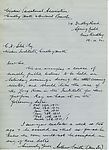In 1903 Albert and Frances Mansbridge established an “Association to Promote the Higher Education of Working Men”. It brought together supporters of working-class education from the churches, the Co-operative Movement, trade unions and the University Extension Movement. In 1905 it was renamed the "Workers' Educational Association" (W.E.A.), in part to recognise that women also had legitimate claims to higher education. The W.E.A. had a long and fruitful connection with The Cradley Heath Workers' Institute, from shortly after it opened in 1912, until well into the 1930s.
The W.E.A. worked in partnership with hundreds of working-class and community organisations. By 1914 there were 179 branches and over 2,500 affiliated societies. The Trade Union Movement accounted for 953 of these affiliations. In the early days, the only funding it received was from the Board of Education, and only for tutorial classes. These were three year courses, with weekly classes and regular essay writing. Fewer women than men were able to make that sort of time commitment.
The first tutorial classes started in Longton, Staffordshire and Rochdale, Lancashire. In 1913 there was enthusiastic approval for a tutorial class at the Cradley Heath Workers' Institute. Sixty names were put forward for a course on economic history.
For those women able to give the time to tutorial classes the impact was remarkable. Maud Royden, an Oxford tutorial class lecturer wrote of her Oldham women students, who were studying Shakespeare, "They not only stayed the course but, at the close of each class, accompanied me down the street to the railway station still arguing and discussing, stood on the platform while I, my head out of the carriage window, continued the class, and made their last contributions to the discussion in shouts above the roar of the train as it pulled out of the station. Can you beat it?" (Munby, 2003, p217)
In addition to tutorial classes the W.E.A. carried out "pioneer" work. Today such work might be called "outreach" or "informal community learning." It included lecture programmes, study circles and social groups. In these settings women outnumbered men. In March 1913 the W.E.A.'s magazine "The Highway reported: “Miss Helen Stocks lectured on education and democracy at the Cradley Heath Workers’ Institute. Miss Stocks worked for the women chainmakers in their strike some time ago so she came as no stranger to the neighbourhood. Her lecture was the first of a series which is proving very successful. There is talk of a preparatory class for next winter. It is possible that a special class for women chainmakers may be started, and the subject that seems to meet with favour is music.” A singing class was established later that year.
A glance through a 1935 copy of “The Torch”, the W.E.A.'s newsletter for the West Midlands, reveals that lectures were given on;
"Education and Citizenship" by Mr. J.M. Forster, B.A., M. Lit.,
"The Theory of Religion in Communism" by Mr. H.G. Wood, M.A.,
"More’s Utopia" by Mr. R.H. Coats,
"The Significance of Nazism in Germany" by Mr. T. Evans,
"The Modern Press and Public Opinion" by Mr. W. Ingham, B.A.,
"What Good are Art and Literature to Me" by Mr. Martin Gilkes, M.A.
The WEA also organised social events. In March 1934 “The Torch” reported on a social held at the Cradley Heath Workers' Institute. Nearly seventy people were present. They were entertained with games, drama, dramatic monologues and piano solos.
The W.E.A. continues today. It is the U.K.'s largest voluntary provider of adult education. It runs over 100,000 courses each year, for adults of all ages, from all walks of life and in particular for those adults who have previously missed out on education.
Rollover the captions in the box to see the available images in thumbnail format, click the caption to see the full-size image
| Reference: | 730 |
| Keywords: | |
| Archive Ref: | |
| Updated: | Tue 17 Jul 2007 - 1 |
| Interpretation written by | Louis Howe |
| Author's organisation | Curatorial |
| Organisation's website |
